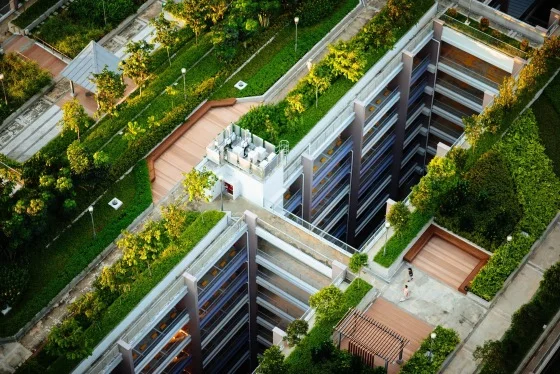What are ESG green buildings?
Environmental, Social, and Governance (ESG) green buildings are the idea of positively impacting the environment and others by investing money. Many companies are addressing climate change and social progress in architecture and design. This means that ESG refers to businesses using their buildings and spaces to invest in environmental and social initiatives. There are many good reasons to consider the use of sustainable design and materials for construction projects, including:
- Governmental regulation
- Business sustainability
- Tax credits
- Reduced operational costs
There are various ways to build upon ESG green buildings by creating sustainable and social equity companies, including energy-efficient fixtures to reduce buildings’ operational carbon footprint and mobility features to improve community access to amenities. In addition, ESG green buildings attract more clients and talent as well as protect investments for long-term use.
ESG green building technology
The use of technology is essential when creating ESG green buildings. Various components must be incorporated, including site planning and design, community, indoor air quality, energy, materials, waste, and water. It helps to stay organized, which can be done by using the ProptechOS platform and apps. So, what does all of this mean for sustainable housing?
- Site planning and design help create affordable housing to access critical services and transportation to tenants. The objective is to plan sites that will blend in and work with natural features in surrounding communities that will provide protection, shade, and manage stormwater runoff. Reducing physical footprint is by creating more compact designs of buildings and parking lots as well as taking care of the conditions of trees and soil during construction.
- Community creates a place to meet, protect, and spaces for pedestrians rather than vehicles. Having green buildings and development makes a strong community. Once green buildings are developed, residents and community members can become involved in planning, operating, and maintaining sustainable design.
- Indoor air quality contributes to the health and comfort of residents. Creating an indoor environment that provides high-quality air involves creating a design, layout, and materials choices. There needs to be ventilation and humidity control, which contributes to energy conservation and longevity of the buildings.
- Energy conservation uses the energy of the sun and wind to adjust the temperature and to create light for green buildings. Modeling software is usually used for designing a more effective HVAC system, lighting, and appliances to develop renewable energy sources.
- Materials need to be green, high-quality building materials that can eliminate or minimize indoor air quality issues, reduce waste, and avoid toxic substances. Using recycled materials can help reduce the use of materials and reduce costs.
- Waste reduction helps reduce, reuse, and recycle construction and demolition waste. It creates a more effective way to use materials and prevents potential waste for longevity.
- Water can be used by installing water-efficient appliances that help with irrigation, conserving, and reducing energy costs. Specific installations that enable water efficiency are drought-resistant plants, rainwater and greywater use, and conserving freshwater resources.
What makes ESG green buildings sustainable?
Sustainable building starts with planning and design. A sustainable building should be able to reduce, control, and treat stormwater runoff that supports flora and fauna. The building should provide the use of reflective light or colors to reduce the use of changing the temperature or have solar panels for energy use. In addition, having significant natural lighting in the building can reduce energy consumption. Lastly, the facility could have low-flush toilets, low-flow showers, or efficient wall and ceiling insulation.
Creating a sustainable building helps to use sustainable materials such as biodegradable or eco-friendly materials. One material that is considered to be eco-friendly is bamboo due to its high growth rate, high-strength ratio, and lasting longer with greater comprehensive strength than concrete and brick. Having materials that need less maintenance will contribute to sustainability because the cost and effort to repair, manage, and replace building materials can drain resources.
Famous sustainable buildings with green architecture
Shanghai Tower (China)
The Shanghai Tower, located in China, was built in 2008 and is one of the tallest buildings in the world. It has various sustainable features, including capturing rainwater for internal usage, and the twisting design reduces wind loads by 24%. Additionally, there are wind turbines that are across the building that can generate around 350,000 kWh of electricity every year.
The Crystal (London, UK)
The Crystal is an event venue in London and one of the world’s most sustainable buildings. It is filled with urban landscaping that surrounds the building. The building is electric with ground source heat pumps. There is solar power that generates over 20% of the electricity for the building.
Museum of Tomorrow (Brazil)
The museum of tomorrow is located in Brazil and is considered an extraordinary example of sustainable engineering. It uses the nearby bay as a cooling system, and the spines of the building are made of solar panels that can be moved in any direction where the sun is facing.
Pixel Building (Melbourne, Australia)
The pixel building is located in Australia and it is the first carbon-neutral structure. It has many sustainable features, including a waste reduction system, water harvesting facility, green roofing, and renewable energy.
Sustainable future
Creating ESG green buildings to create a more sustainable world is essential for environmental and social initiatives. There are several reasons to consider sustainable design and the use of materials. These designs are becoming increasingly popular and the new standard for every industry and community. The goal is to protect the environment while providing long-lasting and protective infrastructures. The growth of planning and designing these developments is still in the works; however, there will inevitably be a shift to a more sustainable future. Proptech enables this and bridges the transition for a better environment, which will help reduce costs and create better opportunities for building management.
References
Will ESG Move the Green Building Needle?
PlaceTech | 5 ways to harness building technology for ESG goals
